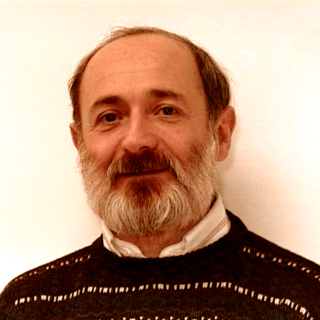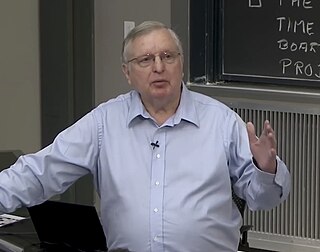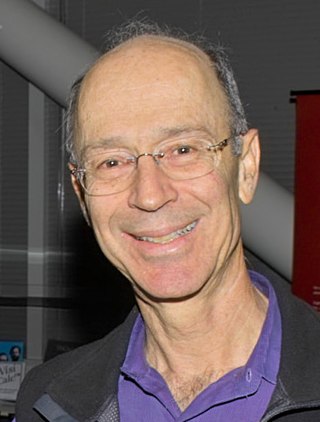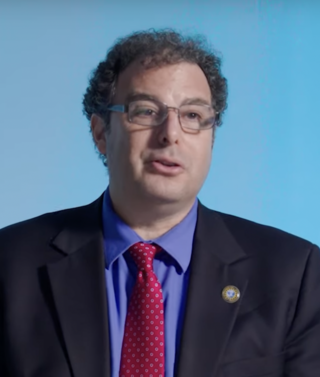Planner is a programming language designed by Carl Hewitt at MIT, and first published in 1969. First, subsets such as Micro-Planner and Pico-Planner were implemented, and then essentially the whole language was implemented as Popler by Julian Davies at the University of Edinburgh in the POP-2 programming language. Derivations such as QA4, Conniver, QLISP and Ether were important tools in artificial intelligence research in the 1970s, which influenced commercial developments such as Knowledge Engineering Environment (KEE) and Automated Reasoning Tool (ART).

Johns Frederick (Jeff) Rulifson is an American computer scientist.
Natural language understanding (NLU) or natural language interpretation (NLI) is a subset of natural language processing in artificial intelligence that deals with machine reading comprehension. NLU has been considered an AI-hard problem.

SRI International (SRI) is a nonprofit scientific research institute and organization headquartered in Menlo Park, California, United States. It was established in 1946 by trustees of Stanford University to serve as a center of innovation to support economic development in the region.

Scott Elliott Fahlman is an American computer scientist and Professor Emeritus at Carnegie Mellon University's Language Technologies Institute and Computer Science Department. He is notable for early work on automated planning and scheduling in a blocks world, on semantic networks, on neural networks, on the programming languages Dylan, and Common Lisp, and he was one of the founders of Lucid Inc. During the period when it was standardized, he was recognized as "the leader of Common Lisp." From 2006 to 2015, Fahlman was engaged in developing a knowledge base named Scone, based in part on his thesis work on the NETL Semantic Network. He also is credited with coining the use of the emoticon.

Boris Katz is a principal American research scientist at the MIT Computer Science and Artificial Intelligence Laboratory at the Massachusetts Institute of Technology in Cambridge and head of the Laboratory's InfoLab Group. His research interests include natural language processing and understanding, machine learning and intelligent information access. His brother Victor Kac is a mathematician at MIT.

Shakey the Robot was the first general-purpose mobile robot able to reason about its own actions. While other robots would have to be instructed on each individual step of completing a larger task, Shakey could analyze commands and break them down into basic chunks by itself.
Jerry R. Hobbs is an American researcher in the fields of computational linguistics, discourse analysis, and artificial intelligence.
Richard Earl Fikes is a computer scientist and Professor (Research) Emeritus in the Computer Science department of Stanford University. He is professionally active as a consultant and expert witness. He led Stanford's Knowledge Systems Laboratory from 1991 to 2006, and has held appointments at Berkeley, Carnegie-Mellon, Price Waterhouse Technology Centre, Xerox PARC, and SRI International.

Charles Rosen was a pioneer in artificial intelligence and founder of SRI International's Artificial Intelligence Center. He led the project that led to the development of Shakey the Robot, "who" now resides in a glass case at the Computer History Museum, in Mountain View, California.

Patrick Henry Winston was an American computer scientist and professor at the Massachusetts Institute of Technology. Winston was director of the MIT Artificial Intelligence Laboratory from 1972 to 1997, succeeding Marvin Minsky, who left to help found the MIT Media Lab. Winston was succeeded as director by Rodney Brooks.

Nils John Nilsson was an American computer scientist. He was one of the founding researchers in the discipline of artificial intelligence. He was the first Kumagai Professor of Engineering in computer science at Stanford University from 1991 until his retirement. He is particularly known for his contributions to search, planning, knowledge representation, and robotics.
STUDENT is an early artificial intelligence program that solves algebra word problems. It is written in Lisp by Daniel G. Bobrow as his PhD thesis in 1964. It was designed to read and solve the kind of word problems found in high school algebra books. The program is often cited as an early accomplishment of AI in natural language processing.

Peter E. Hart is an American computer scientist and entrepreneur. He was chairman and president of Ricoh Innovations, which he founded in 1997. He made significant contributions in the field of computer science in a series of widely cited publications from the years 1967 to 1975 while associated with the Artificial Intelligence Center of SRI International, a laboratory where he also served as director.

Michael Lederman Littman is a computer scientist, researcher, educator, and author. His research interests focus on reinforcement learning. He is currently a University Professor of Computer Science at Brown University, where he has taught since 2012.
Evgeniy Gabrilovich is a research director at Facebook Reality Labs where he conducts research on neuromotor interfaces. Prior to that, he was a Principal Scientist/Director at Google, specializing in Information Retrieval, Machine Learning, and Computational Linguistics, and a Fellow of the Institute of Electrical and Electronics Engineers (IEEE), and an ACM Fellow. In 2010, he received the Karen Spärck Jones Award from the British Computer Society Information Retrieval Specialist Group.
William Aaron Woods, generally known as Bill Woods, is a researcher in natural language processing, continuous speech understanding, knowledge representation, and knowledge-based search technology. He is currently a Software Engineer at Google.
David Leigh Waltz was a computer scientist who made significant contributions in several areas of artificial intelligence, including constraint satisfaction, case-based reasoning and the application of massively parallel computation to AI problems. He held positions in academia and industry and at the time of his death, was a professor of Computer Science at Columbia University where he directed the Center for Computational Learning Systems.

Oren Etzioni is Professor Emeritus of computer science, and founding CEO of the Allen Institute for Artificial Intelligence (AI2). Etzioni is the founder and CEO of TrueMedia.org, a non-profit dedicated to fighting political deepfakes, which launched in April 2024. Etzioni is a Technical Director of the AI2 Incubator, and a venture partner at the Madrona Venture Group.











